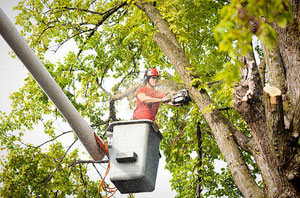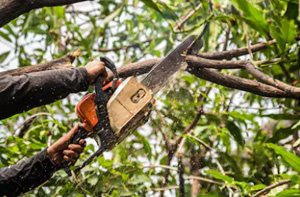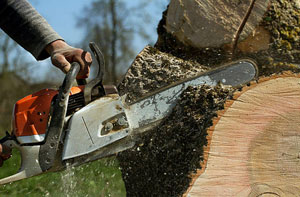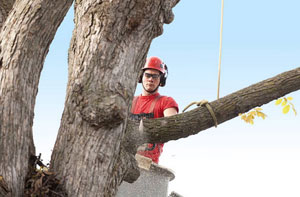Stirling Tree Surgeon Scotland: Trees in your garden and around your property in Stirling, add structure, style and substance to what can oftentimes be a largely two dimensional landscape. This is all well and good, however when trees are poorly maintained, diseased, or affected by extreme weather conditions such as high winds or flooding, issues may occur which will need to be addressed. The safest option if there's work that needs carrying out on your trees, is to seek advice from a trained tree surgeon in Stirling.
Employing unqualified individuals for tree work or trying to do the work on your own, could cause damage to property, harm your trees, or even lead to injury or death. But even using a seasoned tree surgeon who knows all the hazards doesn't mean that tree work is safe. Tree surgery is certainly not a task for amateurs, and on average there are three deaths and 140 severe injuries annually within the industry, making it one of the most dangerous jobs in the UK.

There is also a threat to life from poorly maintained or damaged trees in Stirling, seeing as around five people each year are tragically killed in Britain by falling branches or trees. You may be liable for any compensation to any third-party as a consequence of your actions, if you bring in somebody to do tree work and property is damaged, or an injury occurs. The above are merely some of the reasons why retaining the services of an established Stirling tree surgeon to do the work on your trees is essential. (Source - HSE UK).
An experienced Stirling tree surgeon will likely be an approved member of one or both of the 2 main professional industry bodies. You can check the professional standing and membership of any tree surgeon on the websites of either the International Society of Arboriculture or the Arboricultural Association. Membership of either of these two associations gives the tree surgeon recognised Approved ARB Contractor status which can be checked out on this website.
You're able to get hold of these trade associations for assistance in arbitration and for help and advice, if an issue springs up at any point during the tree work, or after it has been carried out.

If a tree surgeon who isn't on this directory list offers to provide you with a price quote, you are advised to continue your search for an approved and fully qualified contractor, and tactfully decline their offer. Once you are reassured of their professional qualifications and memberships you should try and get a minimum of 3 estimates from different companies in Stirling. Whilst obtaining the quotations you must ask the below questions, making it crystal clear that you need the answers because of the risks involved with the work:
- Precisely what level of insurance coverage have you got? As recommended by the ISA and AA, your tree surgeon ought to be able to show you an insurance certificate covering a minimum of five million pounds public liability.
- Can I assess the quality of your tree work by contacting a person you've worked for recently? It is a good idea to carry out an independent examination of any recent work.
- Can you provide documents to show that you've got the proper qualifications, membership of the ISA or AA, and also a certificate for basic chainsaw use from the NPTC/LANTRA? Any worker/tree surgeon who uses a chainsaw, must by law have gained a NPTC/LANTRA certificate. A skilled tree surgeon in Stirling will probably hold City and Guilds Certificates and National Diplomas in Arboriculture.
- Can you give me a quotation in writing? Only ever accept a written quote. NEVER take a verbal quote alone.
Clear and precise details about all the work that's to be undertaken must be included on the written quote. Who is responsible for removing waste, tree branches and stumps should be stated, as should details about any trees which may be protected in law, and the required steps to obtain permission to carry out work on them. Double check that they have also included VAT on the quote. You've got a responsibility to employ only qualified people to work on your property and trees, and it is extremely important to understand that fact. This is outlined by the "Common law duty of care responsibilities under the Occupier's Liability Acts of 1957 and 1984."
PRIOR TO WORK - Your selected Stirling tree surgeon will need to enquire whether any of your trees are protected and make the necessary steps to make sure that any tree work can get the go-ahead from the local authorities. Even protected trees require maintenance in order to cut back dead or damaged wood and ensure public safety, so finding a tree has protected status does not imply that work can't still be carried out.
No less than 6 weeks written notice must be given to the Local Planning Authority before any tree work can be performed, if your property in Stirling is in a conservation area. This is only required for trees with a trunk diameter of more than seventy five millimetres in diameter, at a point 1.5m from the ground. Also, if a protected tree's branches need to be thinned or pruned in order to promote and stimulate growth, written notice won't be necessary.

On site they'll conduct a complete assessment of your tree's health and decide on the remedial treatment needed and how best and safely to achieve the required outcome. Your property, public areas and any sections of neighbouring properties that could be impacted by falling branches and debris will all be given a full risk assessment. The level of protection required and the number of operatives needed, will also be determined at this stage. To keep property and the general public safe from damage or harm, this will include both personal protection equipment and other safety measures.
ON THE DAY OF WORK - Before any climbing, cutting of branches or tree felling begins, barriers and safety measures will be put in place to keep unauthorised persons and passers-by away from the area of work. It might at some stage be necessary to halt the traffic temporarily, if there is any threat of branches and debris falling onto the road.
Different degrees of protection will be needed by the tree surgeon according to what work needs to be performed. At the very least when doing work with a chainsaw they need to be wearing protective clothing to prevent cutting injuries to the torso, hands and legs. Every worker involved in the operation, should at all times be wearing high-vis clothing, and head and eye protection.
Climbing equipment and ladders will be necessary if any working at height is involved, and to help with the removal of high branches and heavy sections of tree trunk, extra operatives will be essential. For taking waste away from the work area, a truck or skip will be parked as close as possible to the area. This need for access is as good a reason as any for informing your next door neighbours of the intended work.
UPON COMPLETION OF WORK - As soon as the tree work has been concluded all of the waste materials will be hauled away and the whole area cleared of any debris. A certificate of work will then be put together by your tree surgeon, especially when the trees are protected, which can be signed off and a copy handed to you. Highways and footpaths can then be re-opened, with any safety measures in public areas being taken away.
If you have any complaints about or issues with the completed work, you should get them put right immediately by firstly speaking to the tree surgeon. If any further arbitration is needed, and your tree surgeon is a signed up member of a professional body, you can get help and advice from the AA or the ISA so as to come to a satisfactory conclusion.
Locally based Stirling tree surgeons will probably have the phone code 01786 and the postcode FK7. They will operate in Stirling itself, as well as nearby areas such as Alloa, Touch, St Ninians, Kersemill, Whins of Milton, Cambuskenneth, Craigforth, Tullibody, Bannockburn, Fallin, Throsk, Bridge of Allan, Raploch, Cowie, Cambusbarron, Cambus, Causewayhead, and these postcodes: FK7 1SZ, FK7 0EW, FK7 1SQ, FK7 1SL, FK7 7LH, FK7 0QX, FK7 1DW, FK7 0QP, FK7 0DS, FK7 0AX.
For this kind of assistance it's certainly better to hire a competent local tree surgeon. Stirling homeowners can substantially benefit from the skills and knowledge offered by a trained professional.
Tree Stump Removal Stirling
If you're in a position where you've got to have a large tree removed from your garden in Stirling, you're probably going to be left with a stump, which will also have to be sorted out. You may consider allowing it to rot away entirely naturally, and be happy to leave it as it is. However, stumps in your garden can send out suckers in an effort to regrow, and large tree stumps can take several years to break down, during which time they can be an eyesore, a dangerous trip hazard and the ideal home for unwelcome pests, bacteria and fungi.
There are various ways by which a large stump can be removed, if you determine that this is the best plan of action, though the two key choices are stump removal or stump grinding. In the next couple of paragraphs we'll be considering the stump removal alternative rather than stump grinding.
There are essentially three methods of getting rid of a tree stump - digging out by hand, burning or chemical treatments. You could employ any one of these procedures if you want to to remove a tree stump yourself. Professional tree surgeons will most often plump for the aforementioned stump grinding solution, but may suggest a chemical stump removal treatment such as eco-plugging.
Burning a Tree Stump: Since it might contravene local legislation and can certainly be quite dangerous, stump burning is not really a recommended course of action. If you choose this technique, extreme care must be taken. The technique involves drilling a few one inch holes into the stump and continuously filling the holes with vegetable oil and left to sit for aa few days. You should then pile up charcoal around the stump and set light to it. You'll need to monitor this continually until the fire is safely burnt out. Make sure that the fire is fully extinguished when it's totally burned out. You can then dig out the stump ashes and roots after it has fully cooled down.
Other methods include shoveling out and clearing all the soil away from below the stump, and setting a fire in the excavated void that has been created. If your tree stump is in close proximity to fences, other trees or buildings, you should never use any of these burning methods.
Hand Stump Digging: Digging by hand is rather straightforward and will involve digging down, sawing through all the roots, and freeing up the stump. A winch could be necessary in order to complete this process. This is exhausting and laborious work.
Chemical Stump Treatments: Chemical treatment calls for the use of a strong chemical solution for example Roundup Tree Stump Remover, Resolva Xtra Tough Tree Stump Killer or Vitax SBK Stump Killer. When using these products you should always closely follow the instructions, as these chemicals can be extremely hazardous. Your stump will take several weeks to break down and can then be removed with an axe and spade.
(Tags: Stump Digging Stirling, Tree Stump Removal Stirling, Removing Tree Stumps Stirling, Removal of Tree Stumps Stirling).Tree Transplanting Stirling

Digging up a mature tree and transplanting it in an alternative location might sound tricky, however with heavy, modern lifting equipment and truck mounted spades, it's become a comparatively simple task. Mature trees can be replanted onto new ground to accomplish an instant landscaping appearance, or overgrown woody areas can be thinned out without the need to stoop to tree felling.
Moving a tree in Stirling is less stressful on the root system and wellbeing of the tree in the autumn and winter, but it can be achieved during the warmer months by thoroughly soaking the ground before lifting. Removing a fully grown tree will involve a mechanical spade burrowing down and encompassing the root-ball, before lifting the whole tree, unharmed, from the ground. If the uplifted tree isn't going to be straight away transplanted, it can be temporarily stored as long as its root ball and the surrounding earth is kept moist.
Even protected trees can be transplanted by a certified tree moving company in Stirling, so long as all relevant authorisations and preservation orders are approved by the woodland organisations and authorities.
Tree Surveys Stirling
There are a number of reasons why you might need a tree survey, and the most commonplace is for property extension or development. If you are clearing a piece of land in Stirling which has trees growing on it, to make space for an extension to an existing property or a brand new home, you will need to conduct a professional tree survey as required by the British Standards BS5837. Whether a survey is being performed on a private or public property, it should be performed by a qualified Stirling tree surveyor or tree surgeon.
Within the defined area, a properly done tree survey will produce a whole host of information about all the trees. For example:
- The height of each tree.
- The number of trees (those of more than 75mm diameter 1.5m from ground level).
- The ages of the trees.
- The spread of branches towards the South, West, East and North.
- A unique tree reference number for every tree.
- The diameter of each tree (measured 1.5m above the ground).
- The species of trees on the site.
- The predicted life expectancy of the trees.
- Recommendations for tree management.
- The physiological and structural health of the trees.
- The existence of any TPOs.
You will most likely not need a tree survey if you are doing work on an existing home or property in Stirling but you aren't extending the footprint of the property and are not modifying the service lines or access points. (Tags: Stirling Tree Surveys, Arboricultural Surveyors Stirling, Tree Surveys Stirling, Tree Survey Stirling).
Crown Thinning Stirling

If you want to alleviate the stress on specific branches resulting from wind, snow, ice, or gravity, to prevent the tree uprooting when it is windy, to minimize the wind resistance of the tree, to lower the overall weight of the crown or to allow more sunlight in, many of the little incidental branches that are growing inside the outer crown of a broad leafed tree are clipped in a technique that is called crown thinning. The shape and dimensions aren't altered by this process, and the probability is that it will need to be done on a pretty regular basis, as shoots constantly develop. The overall shape and size of the tree ought not to be transformed by crown thinning, and should just produce a uniform foliage density surrounding evenly distributed branches. You will be able to get crown thinning in Alloa, Touch, St Ninians, Kersemill, Whins of Milton, Cambuskenneth, Craigforth, Tullibody, Bannockburn, Fallin, Throsk, Bridge of Allan, Raploch, Cowie, Cambusbarron, Cambus, Causewayhead, and the Stirling area. (Tags: Crown Thinning Stirling, Tree Crown Thinning Stirling, Crown Thin Stirling)
Wood Chipping Stirling

To break down the vegetation, tree limbs and branches that tree surgery creates, the majority of experienced Stirling tree surgeons will frequently use wood chipping machines. Depending on the equipment that is being used, these impressive wood chipping machines can gobble up as much as 40 tonnes of material per hour, although around five tons per hour can be processed by the smaller, more commonly used devices.
Chopped down tree branches are naturally a good deal easier to transport, taking up a lot less space in the tree surgeon's vehicle or trailer, and can also be used for wood pulp, ecosystem restoration, weed prevention, mushroom cultivation, landscaping, biomass fuel, woody mulch and garden pathways, to name just a few.
If you decide that you wish to keep some of the wood chips that result from your tree surgery project, most Stirling tree surgeons will gladly let you keep them. If you don't have any use for them, they will take them away for use on other jobs, or appropriately dispose of them. As I'm sure you'll have realised by reading this write-up, tree surgeons are the best source for wood chips that you can use for various purposes throughout your garden in Stirling, whether you have tree surgery work that needs doing or not. Certain tree surgeons will want paying for wood chippings, particularly if you need them to be delivered, others will let you have them at no cost.
Well known brands of wood chipping machines include Forest Master, Timberwolf, Hyundai and Forst.
Air-Spading Stirling
There are various issues that can affect the health of trees in your garden, and the root system is one of the places to consider whenever you have concerns. Easy accessibility to your tree's roots will be necessary for a professional tree surgeon in Stirling to check for root rot, soil compaction and other plausible issues.
Because there's a chance of causing damage to the roots during the digging process, during the past this was somewhat problematic to achieve. Several contemporary tree surgeons in Stirling use a system known as "air spading", which uses compressed air to successfully break up and strip away compressed soil without any risk of damaging the tree's roots, or any utility lines that happen to be nearby.
The health of a tree can be affected when the soil around the roots becomes compacted by construction work, foot traffic or passing vehicles. A tree can become "stressed" because of a lack of water and nutrients, which makes it more susceptible to attack by pests, disease and insects. Also a good technique for fixing root flare problems, air-spading can be used to effectively remove the excess soil from the base of a tree which has been covered, increasing the possibility of root rot.
This innovative process involves the use of an air compressor and an air-spading tool which blows air into the soil at a speed of twelve hundred miles per hour, the air penetrates the voids in the soil and instantly breaks it up, while leaving tree roots, utility lines and concrete unaffected. As surrounding soil is blown away from the roots by the powerful air flow, immediate inspection can be accomplished. Any obvious problems can then be resolved and the soil exchanged for a less dense layer of wood chips and fertiliser to encourage the tree to rejuvenate. (Tags: Air-Spade Stirling, Air-Spade Investigations Stirling, Air-Spading Stirling).
Storm Damaged Trees Stirling
To most people, trees seem sturdy, strong and capable of standing up to virtually anything that Mother Nature can throw at them. In actual fact certain types of tree can survive for many hundreds of years and happily do so without any issues.
Severe weather can however cause significant damage, and along with the danger of falling tree limbs or branches, entire trees can fall down in certain situations. The principal weather related issue for trees is wind, and as the number of violent storms and weather events in Stirling increases due to climate change, this kind of damage is becoming more commonplace. Extended periods of rainfall or flooding will cause the soil around roots to become waterlogged, which is another issue for larger trees, as is heavy snow in the winter.
To lessen the chance of issues with your trees in severe weather conditions, it is recommended that you get a local Stirling tree surgeon to examine them now and again, and trim any dead, dying or excessively long branches.
Larger trees can also have lightning rods, copper conductors, or other lightning protection systems installed, to lower the risk of them being struck by lightning and to stop surrounding property and buildings being damaged by jumps or "arcs". A lightning strike could kill a tree, or severely weaken it, making it more susceptible to disease and pest attacks. For any of you who reckon that lightning isn't all that common, there are around three hundred thousand strikes in the UK annually.
To safeguard your trees from being damaged by storms and lessen the chances of major consequences should an unsound tree topple over as a result of bad weather, ask your local Stirling tree surgery firm what they can do.
Pollarding Trees Stirling

When a tree has appreciably gotten too big for its current surroundings, it can be considerably reduced in size through a procedure referred to as pollarding. It can sometimes be employed for aesthetic or practical reasons to mould a tree into a particular form. You will sometimes see trees that have been pollarded beside roadways in Stirling, and also fairly frequently in managed hedgerows The somewhat harsh and bare appearance that is the consequence of pollarding isn't at all popular with those who adore trees, seeing that it's so dissimilar to its natural state. The positive aspect of pollarding, is that trees which might otherwise need to be cut down can be saved in-situ. Pollarding is frequently done on broad-leafed species like beeches, planes, sycamores, limes, horse chestnuts, oaks and maples.
Tree Surgery Tasks Stirling

Stirling tree surgeons will likely help with air spading, hedge planting Stirling, crown lifting, dead wooding, root removal, domestic tree surgery, woodchipping, root flare exposure, the protection of trees from grazing animals, tree removal in Stirling, eco plug treatments in Stirling, crown reduction, vegetation management in Stirling, professional tree care, tree staking, hedge reduction, brush cutting services in Stirling, stump treatment Stirling, tree watering, arboriculture in Stirling, crown raising, tree fertilising, tree maintenance, retrenchment pruning in Stirling, tree felling in Stirling, cut sealing, tree cabling, pollarding, dead-wooding, stump grinding and other tree surgeon services in Stirling, Scotland. Listed are just a selection of the tasks that are handled by a tree surgeon. Stirling professionals will tell you about their whole range of services.
Tree Surgeons Nearby
Also find: Bannockburn tree surgeon, Touch tree surgeon, St Ninians tree surgeon, Causewayhead tree surgeon, Throsk tree surgeon, Cambusbarron tree surgeon, Cowie tree surgeon, Cambuskenneth tree surgeon, Cambus tree surgeon, Whins of Milton tree surgeon, Kersemill tree surgeon, Fallin tree surgeon, Raploch tree surgeon, Bridge of Allan tree surgeon, Craigforth tree surgeon and more. The majority of these localities are serviced by tree surgeons. Residents in the area can obtain tree surgery quotations by going here.
Tree Care Services Stirling
- Stirling Tree Dismantling
- Stirling Woodland Management
- Stirling Woodland Clearances
- Stirling Tree Removal
- Stirling Crown Raising
- Stirling Tree Lopping
- Stirling Crown Reduction
- Stirling Tree Surveys
- Stirling Hedge Planting
- Stirling Eco-Plugging
- Stirling Tree Maintenance
- Stirling Tree Reduction
- Stirling Tree Cutting
- Stirling Hedge Trimming
 Tree Surgeon Stirling
Tree Surgeon Stirling Tree Surgeons Stirling
Tree Surgeons Stirling Tree Surgery Stirling
Tree Surgery StirlingTo find out local Stirling info go here
Tree Surgery FK7 area, (dialling code 01786).
Vegetation Management Scotland - Arboriculturalist Stirling - Tree Surgeon Stirling - Tree Surgery Stirling - Tree Management Stirling - 01786 - Woodland Management Stirling - Tree Pruning Stirling - Stump Removal Stirling






